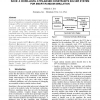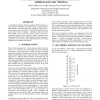12 search results - page 2 / 3 » Random stimulus generation with self-tuning |
JCNS
2008
13 years 8 months ago
2008
Adaptation of the spike-frequency response to constant stimulation, as observed on various timescales in many neurons, reflects high-pass filter properties of a neuron's tran...
ITC
2003
IEEE
14 years 1 months ago
2003
IEEE
Functional verification of complex designs largely relies on the use of simulation in conjunction high-level verification languages (HVL) and test-bench automation (TBA) tools. In...
NIPS
2003
13 years 10 months ago
2003
We explore the phenomena of subjective randomness as a case study in understanding how people discover structure embedded in noise. We present a rational account of randomness per...
ISCAS
2003
IEEE
14 years 1 months ago
2003
IEEE
A deterministic dynamic element matching (DEM) approach to ADC testing is introduced and compared with a common random DEM method. With both approaches, a highly non-ideal DAC is ...
FDL
2008
IEEE
14 years 3 months ago
2008
IEEE
Constraint-based random simulation is state-of-the-art in verification of multi-million gate industrial designs. This method is based on stimulus generation by constraint solving...


